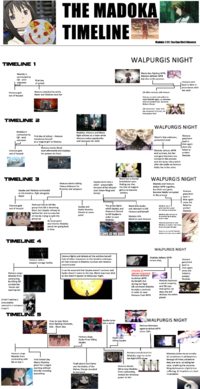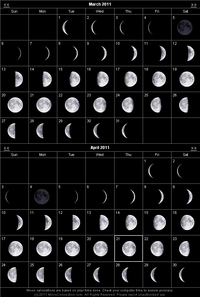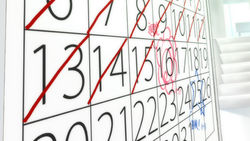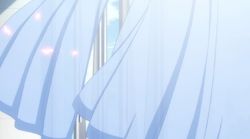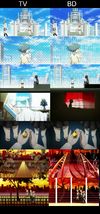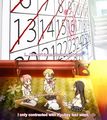Timeline: Difference between revisions
Randomanon (talk | contribs) No edit summary |
Randomanon (talk | contribs) mNo edit summary |
||
| Line 8: | Line 8: | ||
=== Timeline Theory 1 === | === Timeline Theory 1 === | ||
Present day, present time: Homura transfers into school on March 25, 2011, and the events of the anime took place while it was airing on TV in the real world. '''The dates mentioned later in the article follow this hypothesis, but should not be taken as canon.''' | |||
*If that is correct, Episode 12 was originally scheduled to air on the night before the events of Episode 1, and Homura's time loop restart point is during the week after the airing of Episode 10. Since Episodes 11 and 12 were delayed, their final airing dates occur during middle of Sayaka's downfall, on Good Friday. | |||
*This allows for the possibility that the witch [[Walpurgis Night]] appeared on the date of the real-life [http://en.wikipedia.org/wiki/Walpurgis_Night Walpurgis Night]. | |||
*Under this theory, Mitakihara City is most likely located in the southern end of Japan and experienced an early Spring. However, plant growth would be out of season in March, and most Japanese schools follow a calendar that would put Homura's transfer date in the middle of Spring break. A scene in the [http://wiki.puella-magi.net/File:Madoka_BD_7.jpg TV version] showed cherry blossoms after Homura returned to school, which is possible in late March, but they were removed and replaced with bare trees in the BD. | |||
=== Timeline Theory 2 === | === Timeline Theory 2 === | ||
Near or distant future: Homura transfers into school on May 25 of an unknown year later than 2011. | |||
*Director Shinbo described the setting as [[NewType_2010-12|"in the near future, or a distant future"]] in an interview. The technology shown in the classroom and Madoka's home is more advanced than in 2011 Japan. | |||
*Japan's school year starts in April, possibly as early as the 1st though typically on April 5th, not late March. The green foliage [[:Media:Ep 10 Cherry Blossoms blow in.jpg|and cherry blossoms]] make it clear it's the spring term and thus the [[:Media:Ep10-calendar-BD.jpg|31 day month]] would be March or May. Homura is not transferring in on the first day of school, and Madoka's conversation with her mother in episode 1 about her [[:Media:Ep_1_Conversation_Mid_Spring_Term.jpg|teacher and Hitomi]] suggests that it's already well into the spring term. For instance, if school had started only a week ago, Madoka would have said Hitomi received two love letters in a week, rather than a month, suggesting the school term is at least a month in, thus fitting a May rather than March timeframe. | |||
*Madoka's father harvests [[:Media:Ep 1 Plant Growth.jpg|full-grown]] [[:Media:Ep 1 Harvesting Tomatoes.jpg|cherry tomatoes]] in episode 1. In Japan's climate, tomato plants would not be ready to harvest in an outdoor garden at end of March but later in the year such as the end of May. | |||
*Assuming Homura attends school on May 25th, we can still place the events occurring in the anime to be less than two months in duration. The spring school term ends in mid/late July (around the 20th is typical). Madoka and Homura are still wearing their school uniforms when Walpurgis Night arrives, so this must happen before the end of the school term. Furthermore, authorities believed that Walpurgis Night was a [http://en.wikipedia.org/wiki/Supercell supercell], which despite being a rare event in Japan could be possible under the climatic conditions that can occur in Japan's monsoon season (June-July). This likely places Walpurgis Night's attack in late June or early July. | |||
*The conversation Madoka has with her mother in conversation episode 1 about her [[:Media:Ep_1_Conversation_Mid_Spring_Term.jpg|teacher and Hitomi]], makes it sound like it is already well into the spring term. | *The conversation Madoka has with her mother in conversation episode 1 about her [[:Media:Ep_1_Conversation_Mid_Spring_Term.jpg|teacher and Hitomi]], makes it sound like it is already well into the spring term. | ||
Revision as of 23:45, 3 February 2012
This section may contain major spoilers!
Please refrain from reading if you are not yet familiar with all the latest media released.The events of Madoka Magica occur in multiple separate timelines, but form a linear sequence of events from Homura's point of view. The following chronology lists the order of events as Homura experienced them as well as speculation regarding the setting and exact timing of events within individual timelines.
Setting
There are two theories about the date on which the anime is set:
Timeline Theory 1
Present day, present time: Homura transfers into school on March 25, 2011, and the events of the anime took place while it was airing on TV in the real world. The dates mentioned later in the article follow this hypothesis, but should not be taken as canon.
- If that is correct, Episode 12 was originally scheduled to air on the night before the events of Episode 1, and Homura's time loop restart point is during the week after the airing of Episode 10. Since Episodes 11 and 12 were delayed, their final airing dates occur during middle of Sayaka's downfall, on Good Friday.
- This allows for the possibility that the witch Walpurgis Night appeared on the date of the real-life Walpurgis Night.
- Under this theory, Mitakihara City is most likely located in the southern end of Japan and experienced an early Spring. However, plant growth would be out of season in March, and most Japanese schools follow a calendar that would put Homura's transfer date in the middle of Spring break. A scene in the TV version showed cherry blossoms after Homura returned to school, which is possible in late March, but they were removed and replaced with bare trees in the BD.
Timeline Theory 2
Near or distant future: Homura transfers into school on May 25 of an unknown year later than 2011.
- Director Shinbo described the setting as "in the near future, or a distant future" in an interview. The technology shown in the classroom and Madoka's home is more advanced than in 2011 Japan.
- Japan's school year starts in April, possibly as early as the 1st though typically on April 5th, not late March. The green foliage and cherry blossoms make it clear it's the spring term and thus the 31 day month would be March or May. Homura is not transferring in on the first day of school, and Madoka's conversation with her mother in episode 1 about her teacher and Hitomi suggests that it's already well into the spring term. For instance, if school had started only a week ago, Madoka would have said Hitomi received two love letters in a week, rather than a month, suggesting the school term is at least a month in, thus fitting a May rather than March timeframe.
- Madoka's father harvests full-grown cherry tomatoes in episode 1. In Japan's climate, tomato plants would not be ready to harvest in an outdoor garden at end of March but later in the year such as the end of May.
- Assuming Homura attends school on May 25th, we can still place the events occurring in the anime to be less than two months in duration. The spring school term ends in mid/late July (around the 20th is typical). Madoka and Homura are still wearing their school uniforms when Walpurgis Night arrives, so this must happen before the end of the school term. Furthermore, authorities believed that Walpurgis Night was a supercell, which despite being a rare event in Japan could be possible under the climatic conditions that can occur in Japan's monsoon season (June-July). This likely places Walpurgis Night's attack in late June or early July.
- The conversation Madoka has with her mother in conversation episode 1 about her teacher and Hitomi, makes it sound like it is already well into the spring term.
Artistic license: The creators may have made certain decisions for artistic reasons, so anachronisms may occur. For example, the weather and foliage may follow a May setting for visual or symbolic effect, even if Homura's calendar was intended to match the time of the anime's TV airing.
All Timelines
- The backstories of Kyoko and Mami, and the events in Drama CD 3: "Farewell Story".
- 2009: Kyoko becomes a magical girl. In the drama CD, she states that she contracted roughly a year before the battle in which she met Mami.
- 2010: Madoka and Sayaka were in Class 1A in the drama CD's opening scene. They are in their second year during the anime, which is set in 2011, placing this scene in the previous year. Kyoko and Mami become friends. Kyoko loses her family, turns against Mami, and sets out on her own.
- The events in Puella Magi Kazumi Magica probably happened before the timelines diverged, although it's unknown whether this series takes place before or during the anime.
Timeline 1: Ordinary Human Homura
- March 16 (Wed), offscreen: Homura is released from the hospital.
- March 18 (Fri), estimate: Madoka contracts with Kyubey.
- March 25 (Fri): Homura transfers into school and meets Madoka. She is attacked by Izabel and is saved by Madoka and Mami. She learns about magic.
- March 25 - April 30: The first drama CD, Memories of You takes place during this timeline.
- April 23 (Sat): The earliest possible date of Walpurgis Night's appearance.
- April 30 (Sat) - May 1 (Sun): The date of the real life Walpurgis Night, and a possible date of the witch's appearance.
- Mami is killed, while Madoka sacrifices herself to destroy the witch. Homura contracts, her wish being to redo her first meeting with Madoka. Time resets.
Inferences: Sayaka never contracted. Kyoko never came back to Mitakihara.
Timeline 2: Homura is a Magical Girl
- March 16 (Wed): Homura's time loop starts. She is released from the hospital.
- March 18 (Fri), estimate: Madoka contracts with Kyubey.
- March 25 (Fri): Homura transfers into school and tells Madoka she's a magical girl.
- In between March 25 and April 30, but closer to March: Homura shows her powers to Mami and Madoka. Later she makes pipe bombs, and uses them to defeat Patricia. Madoka, Mami, and Homura fought as a magical girl trio.
- April 23 (Sat): The earliest possible date of Walpurgis Night's appearance.
- April 30 (Sat) - May 1 (Sun): The date of the real life Walpurgis Night, and a possible date of the witch's appearance.
- Madoka destroys the witch, but becomes a witch herself. Time resets.
Inferences: Sayaka never contracted. Kyoko never came back to Mitakihara. Mami probably died fighting Walpurgis Night, but since we never see it happen, it's possible she survived (or died earlier).
Timeline 3: The Magical Girl Team
- In this timeline, Kamijou is a guitarist rather than a violinist.
- March 16 (Wed): Homura is released from the hospital.
- March 18 (Fri), estimate: Madoka contracts with Kyubey.
- March 25 (Fri): Homura transfers into school. We can infer that she told Madoka and Mami she was a magical girl.
- In between March 25 and April 30, in estimated chronological order:
- Sayaka contracts and becomes a magical girl.
- It can be inferred that Madoka, Mami, Sayaka, and Homura fought together at least once, and that Sayaka was concerned about getting caught in an explosion.
- It can be inferred Kyoko is somehow contacted, likely by Homura and/or Mami, to help with Walpurgis Night.
- Homura tells Sayaka, Mami, and Madoka about the true nature of witches. Sayaka doesn't believe her, and also distrusts the idea of Kyoko coming to Mitakihara. She also opposes teaming up with Homura. Then Mami suggests that Homura find a new weapon.
- Homura steals firearms from the Yakuza.
- Kyoko comes to Mitakihara town. It can be inferred that she began to care for Sayaka in some fashion (based off her last words in this timeline).
- Sayaka becomes a witch. Madoka, Mami, Kyoko, and Homura fight her, and she is destroyed by Homura. After the battle, Mami snaps and kills Kyoko, and then is killed by Madoka to stop her from killing Homura. It is possible that Madoka picked up Sayaka's Grief Seed after the battle. This event probably happened shortly before April 30th.
- April 23 (Sat): The earliest possible date of Walpurgis Night's appearance.
- April 30 (Sat) - May 1 (Sun): The date of the real life Walpurgis Night, and a possible date of the witch's appearance.
- Madoka and Homura defeat the witch, but are in danger of becoming witches themselves. Madoka uses one last Grief Seed (possibly Sayaka's) to purify Homura's Soul Gem. She then asks Homura to kill her in the current timeline, and stop her from contracting in the next timeline. Homura does what she says. Time resets.
Timeline 4: Homura Fights Alone
- March 16 (Wed): Homura is released from the hospital.
- March 18 (Fri), estimate: Homura prevents Madoka from contracting with Kyubey.
- Between March 18 and April 30:
- Homura kills Kyubey at least once, and warns Madoka against contracting. The exact time is a bit unclear. It is possible that Homura killed Kyubey on March 18th. On the other hand, because Madoka seems to recognize Homura when she appears outside her window, it's possible Homura killed Kyubey on or after March 25th, after transferring into school. It's also possible Homura never went to school in this timeline, focusing entirely on killing witches, and Madoka only recognized Homura from dreaming about a previous timeline.
- Homura steals weapons from the military and fights as many witches as possible.
- April 23 (Sat): The earliest possible date of Walpurgis Night's appearance.
- April 30 (Sat) - May 1 (Sun): The date of the real life Walpurgis Night, and a possible date of the witch's appearance.
- The witch appears different from the one seen in the first timeline. Homura fails to defeat the witch. Madoka contracts with Kyubey and kills the witch with one shot. She then becomes an even more powerful witch that can destroy humanity in ten days. Time resets.
Inferences: Mami, Kyoko and Sayaka were unseen in this timeline, which opens several possibilities. But it's likely that Sayaka didn't contract, Kyoko never came back to Mitakihara, and Mami died before or on Walpurgis Night.
Additional Timelines
It's speculated that an unknown number of timelines fell between Timeline 4 and Timeline 5 while Homura repeatedly attempted to save Madoka.
- Timeline 4.1: The scenes at the end of episode 10, where Homura kills Kyubey, appear to be showing one of them. There are minor differences between these scenes and the similar ones at the beginning of the anime.
- Timeline 4.x: The spin-off manga, Puella Magi Oriko Magica, takes place in a timeline that is not shown in the anime. This timeline happens after Homura changes her hairstyle, but before Madoka eliminates witches. It is believed to fall between timelines 4 and 5, but there has also been speculation that it is part of a separate story continuity and might not fit in with anime timelines.
- According to Homura, the Oriko timeline is considered to be an anomaly, an indicator that the events taking place was highly unexpected.
- It is possible that the Oriko timeline takes place sometime between March 16 and May 1.
- It has been speculated that Oriko may have predicted Walpurgis Night happened in prior timelines. It would explain why Mami knew that Walpurgis Night was coming to Mitakihara in Timeline 1; Kyubey learned it from Oriko and then told Mami.
- Unless a Walpurgis Night event has already happened in the past and this could be common knowledge among veterans, information about a festival of witches is already recorded in history.
- In Episode 8, Kyoko tells Homura that she has never heard of Walpurgis Night ever coming to Mitakihara before, so yes, a Walpurgis Night event has happened in the past, it is a well known event among veteran Puellae Magi, and perhaps it happened in different cities around the globe during the night of the festival of witches.
- However, this doesn't explain why Mami and Madoka in the first timeline would know that Walpurgis Night was coming to Mitakihara. In the anime, Mami says outright that she's training Madoka to help fight it, meaning that she did seem to have some advance knowledge.
- This speculation is unlikely, considering Homura doesn't know Oriko by the time of the Oriko timeline, which she most likely would if the girl had contracted in previous timelines and come into contact with Madoka and co. after the first timeline. Oriko's timeline is also called an "irregular timeline" by Homura, indicating that it was unique from all the others by having Oriko, Kirika and Yuma contracted in it.
- It could be speculated that each year Puellae Magi around the world get ready for a Walpurgis Night event in case it happens to their own city. It is possible that they train to be ready for such a scenario if it ever happens to them. One possible explanation is that Mami is preparing Madoka for a Walpurgis Night event if it ever visits their own city. Since the date of the Witches Festival is well known, they are observing the date and being prepared when the worst case scenario ever hits Mitakihara.
- An additional speculative possibility is that Kyubey was always aware of Walpurgis Night's schedule, but only warns the girls under specific conditions. In later timelines, he might withhold the information in order to pressure an unprepared, panicking Madoka into a contract when the witch attacks.
- However, this doesn't explain why Mami and Madoka in the first timeline would know that Walpurgis Night was coming to Mitakihara. In the anime, Mami says outright that she's training Madoka to help fight it, meaning that she did seem to have some advance knowledge.
- In Episode 8, Kyoko tells Homura that she has never heard of Walpurgis Night ever coming to Mitakihara before, so yes, a Walpurgis Night event has happened in the past, it is a well known event among veteran Puellae Magi, and perhaps it happened in different cities around the globe during the night of the festival of witches.
- Unless a Walpurgis Night event has already happened in the past and this could be common knowledge among veterans, information about a festival of witches is already recorded in history.
- According to Homura, the Oriko timeline is considered to be an anomaly, an indicator that the events taking place was highly unexpected.
- Timeline 4.y: Sunny Day Life, the second drama CD, probably takes place in one of these timelines, since Homura's behavior indicates that she has experienced multiple timelines and matured beyond her initial "Moemura" stage. However, some fans speculate that this timeline occurs earlier or that it is not part of the real story continuity at all.
Timeline 5: The Main Anime Timeline
The number of repetitions Homura has been through before this timeline is greater, but this is the fifth timeline covered in depth by the anime, and it was widely known as timeline 5 among fans after episode 10 aired, so to prevent confusion it is still referred to as timeline 5. This is the main timeline, and the majority of the anime takes place in it.
- March 16 (Wed): Homura's time loop starts again. She is released from the hospital.
- March 18 (Fri), estimate: Homura prevents Madoka from contracting with Kyubey. Note that Homura does NOT kill Kyubey at this point, suggesting she found some other way to keep him away from Madoka.
- March 25 (Fri): Madoka dreams about Walpurgis Night from the previous timeline. However, the witch again appears different. Homura transfers into school. Madoka and Sayaka are introduced to magic and meet Mami. Homura kills Kyubey (for the first time in this timeline), and chases his second body until he meets Madoka. This was the originally scheduled airing date for the final episode.
- March ?? (School day): Madoka tells her mother about visiting Mami's apartment the previous evening. Madoka brings Kyubey to school and encounters Homura on the rooftop. Mami, Madoka, and Sayaka hunt down and defeat Gertrud. Japanese students attend school on Saturday, so it's possible for this to be March 26.
- March/April ?? (School/work day): Sayaka visits Kyousuke to deliver a CD. At night, she and Madoka discuss wishes with Mami. Madoka's mother comes home drunk.
- April 4 (Mon), estimate: Mami dies.
- April 5 (Tues), estimate: Waxing crescent moon. Definitely the next day. Madoka talks to Sayaka and Kyubey on the school roof. Madoka speaks with Homura after visiting Mami's apartment and mentions that Mami's death was yesterday. Sayaka contracts and defeats Elly. Kyoko arrives in town and talks to Kyubey.
- April 6 (Wed), estimate: Hitomi returns to school and mentions her troubles the night before. Sayaka visits Kyousuke, who still has to complete rehabilitation before being released, but plays his violin. Kyoko observes Sayaka through binoculars.
- April 8 (Fri): Kyoko attacks Sayaka in the alley.
- April 9 (Sat): Kyoko talks with Homura, who states that Walpurgis Night is in two weeks. (Homura is referring to the earliest possible date on which the witch might appear. The real life Walpurgis Night event falls on April 30, 21 days later. Two weeks after the 9th is the 23rd.)
- April 9 (Sat): Sayaka visits the alley in which she fought Kyoko to search for the familiar and refers to the battle as happening last night.
- April 10 (Sun): Sayaka visits the hospital only to discover that Kyousuke was released the day before. Sayaka approaches Kyousuke's house and encounters Kyoko, who mentions that Sayaka has been chasing after Kyousuke all day. They fight on the bridge where Madoka throws Sayaka's soul gem.
- April 10 (Sun): Full moon (In the real world, slightly more than a quarter moon). Kyubey tortures Sayaka through her soul gem. Based on Sayaka's comments, this most likely happened immediately after the bridge confrontation.
- April 11 (Mon): Sayaka and Kyoko meet in the church. Sayaka skips school on this day.
- April 12 (Tue): Full moon (In the real world, waxing half moon). Kyousuke returns to school and Hitomi mentions Sayaka's absence the day before. Hitomi delivers her ultimatum to Sayaka. At night, Sayaka goes on patrol and battles Elsa Maria. Sayaka goes missing after this day, according to the news report during her funeral scene in Episode 11.
- April 13 (Wed): Sayaka is absent from school. Hitomi and Kyousuke become a couple. Madoka searches for Sayaka, and learns that she hadn't returned home since the night before.
- April 18 (Mon) - April 22 (Fri): Homura and Kyoko discuss Walpurgis Night in the final scene of Drama CD 3: "Farewell Story". However, this scene may take place in a different timeline, and is only speculated to be part of the main anime timeline.
- April 22 (Fri): Episodes 11 and 12 aired at 2:40 am. Good Friday.
- April 23 (Sat): Two weeks have passed since April 9, when Homura stated that Walpurgis Night was two weeks away. This is the earliest potential date for Walpurgis Night's attack on Mitakihara.
- April ??: Waning crescent moon. Sayaka is killing familiars, and Homura offers her a grief seed. Based on the change from a full moon to a crescent moon, there must be a time skip between the romance scene and the confrontation between Sayaka and Homura.
- April 27 (Wed, or 28th Thu), estimate: Waning crescent moon. Homura kills Kyubey in the park (the second kill in this timeline) and Sayaka becomes a witch.
- April 28 (Thu, or 29th Fri), estimate: Waning crescent moon. Kyoko kamikaze attacks Oktavia, killing them both.
- April 29 (Fri, or 30th Sat), estimate: Sayaka's funeral is held, Junko drinks with Kazuko, and Madoka visits Homura's apartment. Homura states that is has been approximately one month since she transferred into school.
- April 30 (Sat) - May 1 (Sun), estimate: Nearly new moon. Walpurgis Night. At the evacuation shelter, Junko is not wearing the same clothes she had on when she met Kazuko.
- May 1 (Sun): If Walpurgis Night appears on the midnight following April 30 according to the time at the Brocken mountain, matching the witching hour of the real life Walpurgis Night, it would appear in Japan around 8 AM. When Madoka defeats Walpurgis, the clouds part to reveal a blue daytime sky. The sun is not visible, so it is most likely still close to the horizon, as it would be if Walpurgis Night followed Brocken time. The evacuation announcement in the BD states the time to be 7:30 AM, which leaves just enough time for the citizens to flee to the shelter before the battle begins. Germany is in UTC+1, and JST is UTC+9, so assuming Walpurgis Night uses astronomical midnight (She doesn't care about the EU's daylight savings regulations), the exact time of her appearance would be 8:17:34 AM in Japan.
Discrepancies:
- When Homura talks to Kyoko at the arcade, she states that Walpurgis Night is two weeks away, although the date of the real life Walpurgis Night event falls three weeks later. In Drama CD 3: "Farewell Story" Homura indicates that the exact time of Walpurgis Night's appearance varies, and that the earliest observed time is on a weekend. April 23 is a Saturday, so Homura's "two weeks" referred to the earliest possible date.
- On April 10 and 12, the full moon shown in the anime does not match the half moon that occurred in real life. The moon phases observed in the anime are only compatible with the real moon if SHAFT is rounding the moon off to either a full or crescent shape for visual effect, and the Walpurgis Night witch appears near the real life date of Walpurgis Night.
Timeline 6: The New World
A new timeline begins after Madoka makes her wish in Episode 12 and recreates the universe.
- April 2011: Kyousuke is healed, auditions, and becomes a concert violinist.
- Spring 2011: Sayaka kills herself by using up all of her power. Homura, Mami, and Kyoko, who were fighting alongside her, mourn her death in the train station.
- Spring 2011: Homura talks to Madoka's family in the park.
- Full moon. Homura discusses the history of the universe with Kyubey and battles demons in Mitakihara City.
- Unknown year: Homura battles demons in the middle of a wasteland outside of Japan. It is unclear whether this happens shortly after the other events, or takes place in the distant future.
In the anime, Hitomi gives one day's notice in Episode 7 and makes her move in Episode 8. Madoka is desperately searching for Sayaka and learns from Sayaka's parents that she hasn't come home since the previous night. These scenes occur only one day after the events of Episode 7. However, the moon is a thin waning crescent in Episode 8 and is full in Episode 7. A time skip must have occurred between those scenes and the confrontation between Sayaka and Homura. The news report heard during Sayaka's funeral suggests that she has been missing for some time, supporting the idea of a time skip.
Number of Timelines
The total number of timelines Homura went through is not stated. Gen Urobuchi, the writer, left many other issues open-ended, and most likely did not decide on a specific number. However, there are various speculations regarding the number of timelines.
Each timeline runs from March 16 until May 1, assuming Homura always resets immediately after Walpurgis Night. This is a span of 46 days. Eight loops add up to 368 days, just over a year. Sixty loops would require about seven and a half years, and Homura would have to loop 795 times to break a century. Since Homura is willing to reset time earlier if the situation calls for it, the 46 days per timeline figure is only an upper bound. However, if Homura is able to reset time from a later point, there may have been timelines in which Homura avoided fighting Walpurgis Night and a larger amount of time passed before a reset became necessary.
- Absolute minimum: The four timelines explored in depth in episode 10, the timeline at the end of episode 10 that looks similar but slightly different than the scene in episode 1, the main anime timeline, the new world, Oriko, and Sunny Day Life add up to nine timelines that have been explicitly shown, assuming they are all canon and the end of episode 10 was free of animation errors.
- Small numbers: There are 14 strings of fate attached to Madoka in the symbolic image displayed during Kyubey's lecture to Homura. If they directly represent timelines, rather than being drawn in that quantity for artistic reasons, there would be 16 timelines counting the main one and the new world. The anime's opening shows 11 slides when the scenes of Madoka as a magical girl are displayed with Madoka and Kyubey sitting in the foreground, which has lead to speculation that the main timeline is the 12th. Some fans believe that Homura's level of experience and degree of personality change indicate that she has only been through a small number of timelines: She was shocked to see Mami die in battle against Charlotte, she still has trouble handling misunderstandings with other people, she didn't hear Kyubey's explanation as to why Madoka is so powerful until the main timeline, her vulnerable inner personality remains under her cold outer shell, and she's still entirely sane, despite being heavily stressed.
- Medium numbers: Some believe that Homura experienced dozens, but less than a hundred timelines. This would allow her to exhaustively test a number of different strategies, but still have new ideas to try. She appears to have only tried the "give Madoka the cold shoulder" strategy a few times, and probably wouldn't attempt it before convincing herself that other plans won't work. Homura has her statistics (assuming that she was telling the truth about that), she's practiced enough at acting to come off as naturally cool and stylish to everyone despite having been extremely awkward in the beginning, she has memorized all the math perfectly even though homework is the least of her problems, and her elaborate setup against Walpurgis surely required quite a bit of trial and error to perfect and involved gathering a lot of gear that would be tricky to steal. However, she still encounters unexpected situations and hasn't figured out the ideal way to handle every issue that arises.
- Large numbers: Some speculators believe that Homura has truly been through countless timelines. One common estimate is 83 years in 1000 timelines, which assumes an average rate of one month per timeline. One might believe that Homura spent 80 years studying how to be cool.
Calendar and Climate
The calendar we see in Homura's hospital room reads "leaving hospital" on Wednesday the 16th and "going to school" on Friday the 25th. March has 31 days with the 25th falling on a Friday in 2011, and is the only such month in 2011.
The anime shows a full moon on the night when Sayaka's gem is thrown off the bridge and two days later when she fights Elsa Maria and runs away from home. The announcement of her funeral states she went missing on the 12th day of the month, so the moon should be full near June 10-12 if Homura transferred in May, or April 10-12 if she transferred in March.
This table lists the times when May 25th is a Friday from 2011 until the end of the 21st century. Moon phases are based on New York time. The offset column lists the number of days between June 11 and the nearest full moon. April 2011 had a full moon on the 17th, giving the March 2011 scenario an offset of 6.
| Date | Moon Phases | Offset |
|---|---|---|
| May 2012 | May 5: Full May 20: New June 4: Full June 19: New | 7 |
| May 2018 | May 15: New May 29: Full June 13: New June 28: Full | 13 |
| May 2029 | May 13: New May 27: Full June 11: New June 25: Full | 14 |
| May 2035 | May 7: New May 22: Full June 5: New June 20: Full | 9 |
| May 2040 | May 10: New 19 May 26: Full June 9: New June 24: Full | 13 |
| May 2046 | May 5: New May 19: Full June 4: New June 18: Full | 7 |
| May 2057 | May 3: New May 18: Full June 2: New June 16: Full | 5 |
| May 2063 | May 12: Full May 27: New June 10: Full June 26: New | 1 |
| May 2068 | May 1: New May 17: Full 24 June 15: Full June 29: New | 4 |
| May 2074 | May 10: Full May 25: New June 9: Full June 24: New | 2 |
| May 2085 | May :9 Full May 2:3 New June 7: Full June 21: New | 4 |
| May 2091 | May 3: Full May 18: New June 1: Full June 16: New | 10 |
| May 2096 | May 7: Full May 21: New June 5: Full June 20: New | 6 |
Cherry blossom petals were seen blowing into Homura's hospital room shortly before her discharge on the 16th. None were seen later in the show in the BD version, suggesting that the petals had finished falling by the time she entered school on the 25th. This is possible if Homura transferred in May and Mitakihara City is located in northern Japan, but petals would not be falling in the middle of March.
The TV version had cherry trees in bloom when the girls hunted Gertrud in episode 2, but in the BD version the trees were bare. This scene took place shortly after Homura returned to school, so blooming trees would be present in late March in southern Japan, and the petals would have already fallen by the end of May in all regions.
This table lists the cherry blossom seasons in several cities. Times can vary by more than a week depending on weather. Petals from late-blooming trees may be falling up to three weeks after most trees bloom.
| City | Average Opening | Average Full Bloom | 2011 Full Bloom |
|---|---|---|---|
| Tokyo, central Japan | March 28 | April 5 | April 8 |
| Hirosaki, north end of the main island | April 24 | April 30 | May 1 |
| Sapporo, northern island | May 5 | May 8 | May 9 |
| Kumamoto, southern Japan | March 24 | April 2 | April 2 |
Trivia
- The Prolog im Himmel title card at the beginning of episode 1 contains runes reading 2011. This may indicate that the story is set in 2011, but it may also refer to the year of the anime's publication.
- The exchange rates displayed in the bathroom in episode 1 are compatible with a date in Spring 2009, such as April 3. However, this cannot be used to judge the story's setting since Shinbo stated it wasn't set in the past and SHAFT would have much bigger budgets if they were capable of accurately predicting future exchange rates.
